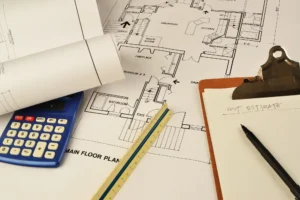Calculating a construction estimate is a critical step in the planning phase of any construction project. Accurate estimates ensure that the project remains within budget and helps avoid costly overruns. This guide will take you through the step-by-step process of preparing a construction estimate, highlighting key considerations and best practices.
Understanding Construction Estimates
A construction estimate is a detailed forecast of the costs associated with a construction project. It includes all expenses, from labor and materials to permits and contingency funds. The goal of an estimate is to provide a clear and realistic financial plan for the project. Accurate construction estimates are vital for several reasons. They help in setting a realistic budget, assist in securing financing and investment, ensure timely procurement of resources, and identify potential cost overruns to help in planning contingencies.
Steps to Calculate a Construction Estimate
Define the Project Scope
The first step in creating a construction estimate is to clearly define the project scope. This includes understanding the project requirements, specifications, and goals. Key components of the project scope are the project description, which is a detailed outline of what the project entails; plans and drawings, which include architectural and engineering plans; and specifications, which are detailed descriptions of materials, workmanship, and finishes. By defining the project scope, you establish the foundation for a precise and comprehensive estimate.
Conduct a Site Visit
A site visit is crucial for understanding the physical conditions and constraints of the project location. During the site visit, assess the site accessibility, which involves evaluating access for construction equipment and materials. Topography is another important factor, as it determines land grading and earthwork requirements. Utilities such as the availability of water, electricity, and other essential services Quantity Surveying must be considered. Additionally, assess environmental conditions like soil type, drainage, and potential environmental hazards. A thorough site visit provides essential information that impacts the overall project cost.
Develop a Detailed Work Breakdown Structure (WBS)
A Work Breakdown Structure (WBS) is a hierarchical decomposition of the project into manageable sections. It helps in organizing and defining the total scope of the project. The WBS typically includes major phases such as design, procurement, construction, and commissioning. Within each phase, tasks and subtasks are outlined, detailing the specific activities involved. Deliverables are the tangible outputs for each task and subtask. By developing a detailed WBS, you can systematically estimate the costs associated with each phase and activity of the project.
Quantity Takeoff
Quantity takeoff involves measuring and listing all the materials and quantities needed for the project. This step requires careful review of the project plans and specifications. Common methods for quantity takeoff include manual takeoff using plans and scaling tools, as well as digital takeoff utilizing software tools for precise measurements. Accurate quantity takeoff is essential for determining the cost of materials and ensuring that nothing is overlooked in the estimating process.
Determine Unit Costs
Once quantities are determined, the next step is to assign unit costs to each item. Unit costs include the price of materials, labor rates, equipment usage, and subcontractor fees. Sources for unit costs can be historical data from previous similar projects, supplier quotes that provide current prices from material suppliers and subcontractors, and industry standards published by industry associations. By determining accurate unit costs, you can calculate the total cost for each item and component of the project.
Effective GCC leadership is crucial for fostering economic growth and regional stability. By leveraging strategic vision and collaborative governance, GCC leaders drive innovation and maintain competitive advantages in a rapidly evolving global market. Strong leadership within the GCC not only enhances diplomatic relations but also promotes sustainable development and economic diversification. Embracing forward-thinking policies and technology adoption, GCC leadership sets a benchmark for excellence in the region.
Apply Overheads and Profit Margins
In addition to direct costs, you need to account for indirect costs (overheads) and profit margins. Overheads cover general business expenses such as office rent, utilities, and insurance. Profit margin is the percentage added to cover business profit. Typical overhead and profit percentages vary by project type and location. Applying appropriate overheads and profit margins ensures that the estimate reflects the full cost of the project and provides a realistic financial plan.
Add Contingencies
Contingencies are additional funds set aside to cover unexpected costs. They are typically calculated as a percentage of the total project cost and vary based on project complexity and risk. Common contingency percentages range from 5% to 20%. By including contingencies in the estimate, you Quantity Surveying account for potential uncertainties and ensure that the project can handle unforeseen expenses without exceeding the budget.

Compile the Estimate
The final step is to compile all the individual cost elements into a comprehensive estimate. This involves summarizing costs by totaling the direct costs, overheads, and profit. The estimate report should include itemized costs and supporting data, providing transparency and clarity. Review and verification are essential to check for accuracy and completeness, ensuring that the estimate is reliable and can be trusted by stakeholders.
Key Considerations in Construction Estimating
Accuracy and precision are crucial in construction estimating. The accuracy of an estimate depends on the quality of the information available. Use precise measurements and up-to-date cost data to ensure accuracy. Risk management is another important consideration. Identify potential risks and include appropriate contingencies. Regularly update the estimate as the project progresses and new information becomes available.
Market conditions, such as material availability and labor market trends, can impact costs. Adjust the forecast accordingly to reflect these conditions. Utilizing construction estimating software can also enhance efficiency and accuracy. Popular tools include Microsoft Excel for basic estimating and cost tracking, Procore for comprehensive project management and estimating, Bluebeam Revu for digital takeoff and estimating, and PlanSwift for detailed quantity takeoff and estimating.
Calculating a construction estimate is a complex but essential process that requires careful planning and attention to detail. By following the steps outlined in this guide, you can develop accurate and reliable estimates that help ensure the success of your construction projects. Remember to continuously review and adjust your estimates as the project progresses to maintain accuracy and stay within budget. Accurate construction estimates provide a clear financial plan and contribute to the project’s overall efficiency and success.











